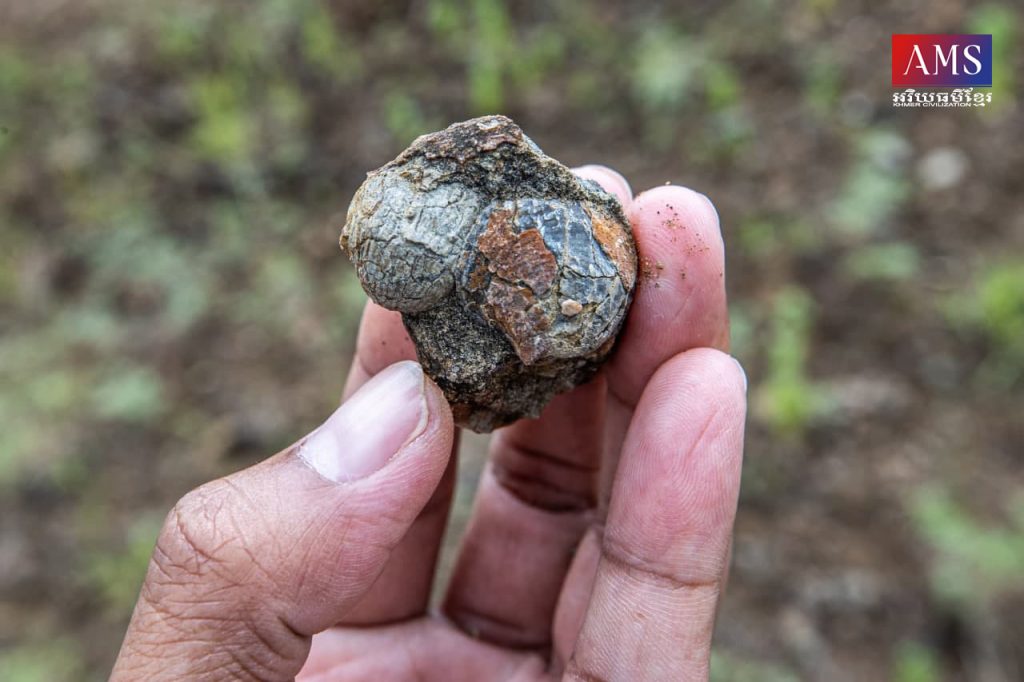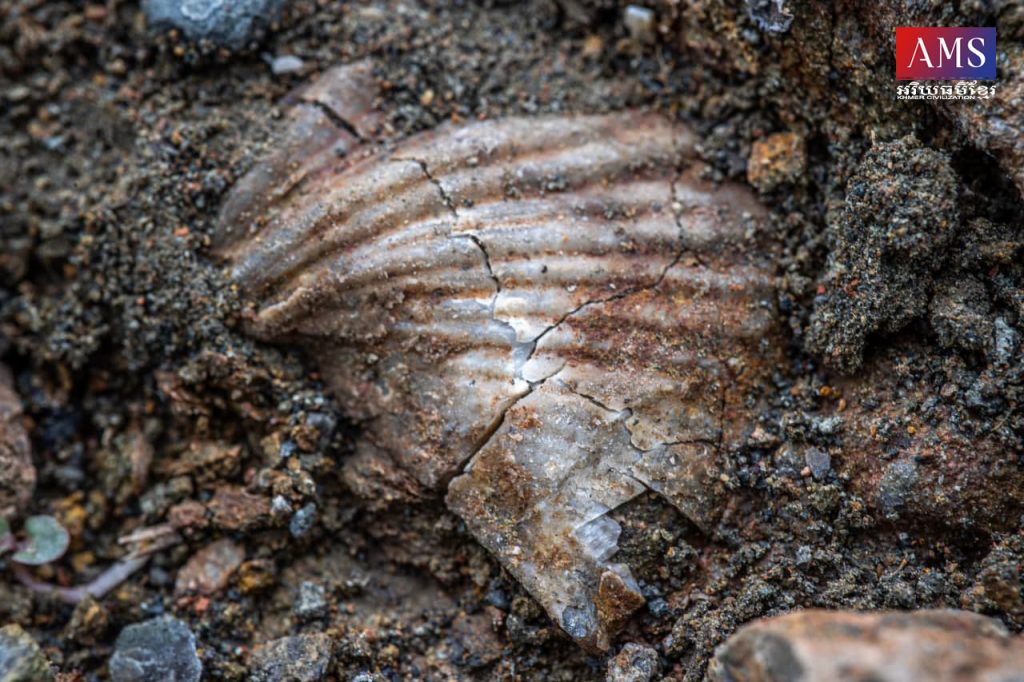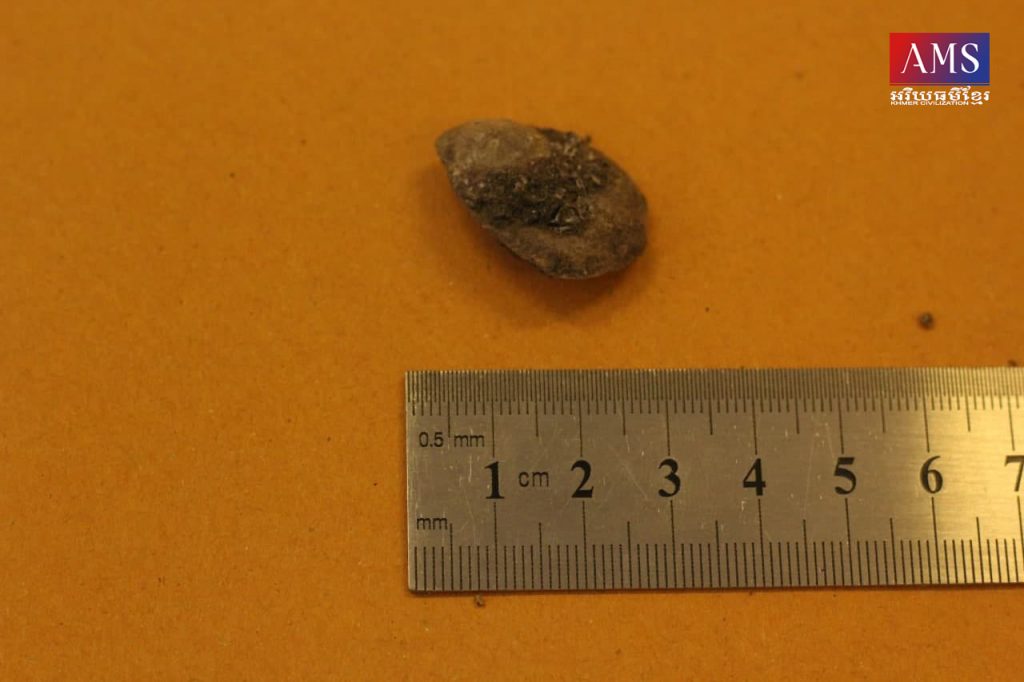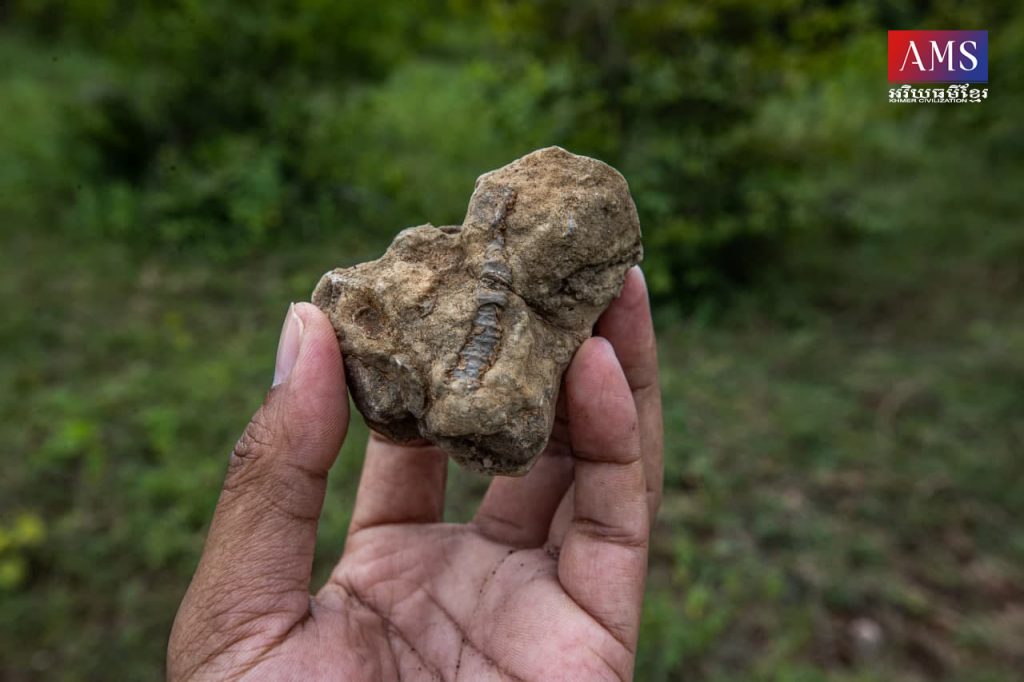“Fossils found at Phnom Bak”, Phnom Bak is a marine fossil side that the team visited in 2019 and 2020. This mountain is located in Serey Sophorn City, Banteay Meanchey Province. Phnom Bak is designated as a Phnom Bak Natural Heritage Site with Sub-Decree No. 71 dated May 25, 2020, covering an area of 36 hectares. Phnom Bak is a limestone mountain but is composed of many layers of rock and soil. Layers have emerged that can indicate multi-stage environmental changes, sometimes perceived as deep flooding, sometimes muddy, sometimes with large inflow rocks. The animal specimens that we have shown before, such as in the Kangva Mountains, are subject to change and variation, possibly related to the living environment or the water depth, even though they are at different times. The Phnom Bak area is marked by the PLS Limestone of the Permian Period, which is 251-299 million years.
We have found no less than 30 species of marine fossils in Phnom Bak, some of which we have not yet identified, such as one type of fossil that resembles a grain of Fusulinina, some frozen and some buried in black soil, still in its original form, and can also be mistaken for a grain of rice. In this group, there are also other species found there, which belong to the family Globigerinidae. Coral reefs found in the upper part of the mountain, these corals are buried in rocks. A small type of coral called horn coral was also found in one of the deeper layers of the mountain. Brachiopods species found many species from the top of the mountain to the bottom layer. Some of these groups are shaped like snails, they have a sharp central pod on both sides. There is a species called Kachiv, a sea creature in the group of Brachiopods that survives every day in Cambodia. Bivalvia species, which includes oysters, clams, etc., but for this period they are not very abundant. Crinoid species encountered them in the deep soil layer. Ammonites species, these species are similar to snails, they were few in number in the first era and continued to thrive in the second era. Bryozoa species have also seen them there, which look like nets.
There are many other species that we have not yet been able to identify. In short, Phnom Bak is a site with a past as the Old Sea. According to a recent study, Phnom Bak is a large marine fossil side. This location is important for research or as an information center on marine fossils that need to be conserved.
ភ្នំបាក់ ជាស្ថានីយ៍ផូស៊ីលសត្វសមុទ្រមួយ ដែលក្រុមការងារបានទៅដល់កាលពីឆ្នាំ២០១៩ និងឆ្នាំ២០២០។ ភ្នំនេះស្ថិតនៅក្នុងក្រុងសិរីសោភណ្ឌ ខេត្តបន្ទាយមានជ័យ មានចំនុចនិយាមការ 272746-1503738។ ផ្នែកខាងលិចភ្នំនេះមានវត្តមួយនៅជើងភ្នំ និងមួយទៀតនៅខាងលើភ្នំ និងមានរូងភ្នំជាច្រើន។ ភ្នំបាក់ត្រូវបានដាក់ជាតំបន់បេតិកភណ្ឌធម្មជាតិ ភ្នំបាក់ ដែលមានអនុក្រឹតលេខ ៧១អនក្រ.បត ចុះថ្ងៃទី២៥ ខែឧសភា ឆ្នាំ២០២០ ដែលមានទំហ៊ំដី៣៦ហិចតា។
ភ្នំបាក់ជាភ្នំថ្មកំបោរ តែមានដោយស្រទាប់ថ្ម និងដីជាច្រើនស្រទាប់លាយឡំ។ ភ្នំនេះត្រូវបានគេកកាយយកអាចម៍ដី ជ្រុងខាងកើត និងជ្រុងខាងត្បូង អស់ជាច្រើន។ ស្រទាប់ទាំងឡាយបានលេចចេញ ដែលអាចបញ្ជាក់អំពីការប្រែប្រួលនៃបរិស្ថានច្រើនដំណាក់កាល ពេលខ្លះអាចយល់ថាទឹកលិចជ្រៅ ពេលខ្លះជាភក់ ពេលខ្លះមានគ្រួសដែលទទួកទឹកហូរចូលខ្លាំងជាដើម។ សំណាកសត្វទាំងឡាយដែលយើងបានបង្ហាញពីមុនដូចនៅភ្នំកងវ៉ា មានការផ្លាស់ផ្តូរនិងប្រែប្រួលអាចពាក់ព័ន្ធបរិស្ថាន នៃការរស់នៅ ឬជម្រៅទឹកផងដែរ ទោះវាស្ថិតនៅក្នុងសម័យកាលប្រហាក់ប្រែលគ្នាក៏ដោយ។ តំបន់ភ្នំបាក់នេះមានកំណត់សំគាល់ PLS ថ្មកំបោរសម័យ Permian Period មានអាយុកាល ២៥១-២៩៩លានឆ្នាំ។ យើងបានរកឃើញប្រភេទផូស៊ីលសត្វសមុទ្រជាច្រើននៅភ្នំបាក់នេះ មិនតិចជាង៣០ ប្រភេទនោះទេ ដោយប្រភេទខ្លះយើងពុំទាន់កំណត់ថាជាប្រភេទអ្វីនៅឡើយដូចជា៖
១. ស៊ីលមួយប្រភេទមានលក្ខណៈដូចគ្រាប់អង្ករ Fusulinina ខ្លះបានកកជាថ្ម និងខ្លះកប់ក្នុងដីខ្មៅនៅមានទ្រាយដើមនៅឡើយ ហើយក៏អាចមានការច្រលំថាជាផូស៊ីលគ្រាប់អង្កផងដែរ។ នៅក្នុងក្រុមពួកនេះក៏មានពពួកផ្សេងដែលរកឃើញនៅទីនោះផងដែរ ដែលស្ថិតក្នុងគ្រួសារ Globigerinidae វាមានលក្ខណៈជាដុំមូលៗខ្លះក៏មានជាប់គ្នា និងខ្លះក៏ដាច់គ្នាមានតូចមានធំ។
២. ពពួកផ្កាថ្ម បានរកឃើញនៅផ្នែកខាងលើនៃកំពូលភ្នំ ផ្កាថ្មនេះកប់ជាប់នៅក្នុងថ្ម មានស្នាមក្រឡាធំៗ ចង្កេះភ្នំពួកខ្លះបានកប់នៅក្នុងដីនិងអាចរកបានទាំងមូល។ ផ្កាថ្មមួយប្រភេទដែលមានទំហំតូច ហៅថាផ្កាថ្មស្នែងត្រូវបានរកឃើញនៅស្រទាប់ជ្រៅមួយនៃភ្នំនេះផងដែរ វាស្ថិតនៅជ្រៅជាងផ្កាថ្ម២មុន ពពួកនេះបានជួបប្រទះក្នុងជម្រៅ។ បើសិនយើងពិនិត្យលើស្រទាប់ដីវិញនោះពួកនេះមានវ័យកាន់តែចាស់ជាង២ប្រភេទមុន។
៣. ពពួក Brachiopods យើងបានរកឃើញពពួកនេះជាច្រើនប្រភេទ ពីកំពូលភ្នំបន្តមកស្រទាប់ខាងក្រោមផងដែរ ក្រុមនេះខ្លះមានរូបរាងដូចងាវ វាផតកណ្តាល ស្រួចសងខាងមានរាងស្តើងសំប៉ែត។ ពួកនេះបានរកឃើញជាច្រើនប្រភេទតែក៏មិនទាន់បានសិក្សានៅឡើយ។ ក្នុងនោះមានមួយប្រភេទហៅថាកាឈីវ ជាសត្វសមុទ្រនៅក្នុងក្រុមនៃ Brachiopods ដែលរស់រានដល់រាល់ថ្ងៃក្នុងប្រទេសកម្ពុជាយើង។
៤. ពពួក Bivalvia ដែលមានពពួកលាស ងាវ គ្រុំជាដើម យើងក៏បានជួបប្រទះមួយចំនួនផងដែរ តែសម្រាប់សម័យកាលនេះពួកនេះមិនសូវសម្បូរទេ។ ផូស៊ីលដែលរកឃើញ មានលក្ខណៈដូចពពួកសែល។
៥. ពពួកខ្យងក៏រកបានជាច្រើនប្រភេទផងដែរ ដែលយើងមិនទាន់អាចកំណត់ឈ្មោះពួកវាបាននៅឡើយទេ។ វាមានពីទំហំទូចដល់ជាង១០ស.ម។
៦. ពពួក Crinoids យើងបានជួបប្រទះពួកនេះនៅក្នុងស្រទាប់ដីជ្រៅ ចំណែកនៅកំពូលភ្នំយើងមិនទាន់បានជួបប្រទះពពួកនេះនៅឡើយទេ។
៧. ពពួក Ammonites ពពួកនេះមានលក្ខណៈប្រហាក់ប្រហែលខ្យង ពួកនេះមានតិចតួចនៅឡើយនៅស័កទី១ និងបន្តរីកចំរើននាស័កទី២។ យើងបានរកឃើញប្រភេទនេះខ្លះដែរ នៅតំបន់នេះ។
៨. ពពួក Bryozoa យើងបានជួបពពួកនេះនៅទីនោះផងដែរ ដែលមានលក្ខណៈដូចសំណាញ់។
៩. ពពួក Sponges ពេលដែលនៅរស់មានទ្រង់ទ្រាយសណ្ឋានដូចផ្កាថ្ម តែវាមានលក្ខណៈទន់ៗ ដូចអេប៉ុង។
មានប្រភេទជាច្រើនទៀតដែលយើងពុំទាន់អាចកំណត់អត្តសញ្ញាណពួកវាបាននៅឡើយ។ រួមសេចក្តីមកទីតាំងភ្នំបាក់ជាទីតាំងដែលមានអតីតកាលជាសមុទ្រចាស់។ តាមការសិក្សាស្រាវជ្រាវថ្មីៗនេះភ្នំបាក់ជាស្ថានីយផូស៊ីលសត្វសមុទ្រដ៏ធំមួយ ទីតាំងនេះមានសារៈសំខាន់សម្រាប់ការសិក្សាស្រាវជ្រាវ ឬសម្រាប់ធ្វើជាមន្ទីរពត៌មានស្តីអំពីផូស៊ីលសត្វសមុទ្រដែលចាំបាច់ត្រូវថែរក្សា។
អត្ថបទដើម៖ លោក លឹម វណ្ណច័ន្ទ

















